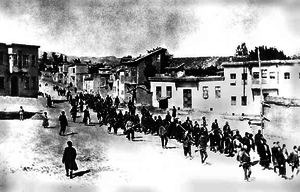ஆர்மீனிய இனப்படுகொலை
ஆர்மீனிய இனப்படுகொலை, ஆர்மேனிய இனப்படுகொலை அல்லது ஆர்மேனிய பெரும் இனவழிப்பு (Armenian Genocide) என்பது ஒட்டோமான் பேரரசுக் காலத்தில் ஆர்மீனியர்களை வலிந்து திட்டமிடப்பட்டு படுகொலை செய்யப்பட்ட நிகழ்வு ஆகும். இது முதலாம் உலகப் போருக்குப் பின்னர் நிகழ்ந்தது.[8] பெரும் படுகொலைகளாகவும், சாவுக்கு இட்டுச்சென்ற வெளியேற்றங்களாகவும் இது நிகழ்ந்தது. இதில் ஒன்றில் இருந்து ஒன்று அரை மில்லியன் ஆர்மேனியர்கள் படுகொலை செய்யப்பட்டார்கள். இக்காலப்பகுதியில் ஆர்மீனியர்களைத் தவிர அசிரியர்கள், மற்றும் கிரேக்கர்களும் ஒட்டோமான் பேரரசினால் படுகொலை செய்யப்பட்டனர்.[9]
| ஆர்மீனிய இனப்படுகொலை | |
|---|---|
| Part of ஆர்மீனிய எதிர்ப்பு | |
 ஏப்ரல் 1915 இல் ஆர்மீனிய மக்கள் துருக்கிய இராணுவத்தினரால் மெசிரே சிறைச்சாலைக்குக் கொண்டு செல்லப்படுகின்றனர். | |
| இடம் | உதுமானியப் பேரரசு |
| நாள் | 1915[note 1] |
| தாக்குதலுக்கு உள்ளானோர் | ஆர்மீனியர் |
| தாக்குதல் வகை | நாடு கடத்தல், பெருமளவு கொலை |
| இறப்பு(கள்) | 1.5 மில்லியன்[note 2] |
| தாக்கியோர் | ஐக்கிய, முன்னேற்ற ஒன்றியம் (இளம் துருக்கியர்) |
இவ்வினப்படுகொலை 1915 ஆம் ஆண்டு ஏப்ரல் 24 ஆம் நாள் ஆரம்பமாகியது. இந்நாளில் ஆர்மீனியக் கல்விமான்கள் மற்றும் சமூகத் தலைவர்கள் 250 பேரை ஒட்டோமான் இராணுவத்தினர் கொன்ஸ்டண்டீனப்போல் நகரில் கைது செய்தனர்[10]. அதன் பின்னர் இராணுவத்தினர் ஆர்மீனியப் பொதுமக்களை அவர்களின் இருப்பிடங்களில் இருந்து வெளியேற்றி பல நூறு மைல்களுக்கு அப்பால் உள்ள பாலைநிலத்துக்கு (தற்போதைய சிரியா) நடைப்பயணமாக அழைத்துச் சென்றனர். அவர்களுக்கு உணவோ, நீரோ வழங்கப்படவில்லை. வயது, மற்றும் பால் வேறுபாடின்றிப் பலர் படுகொலை செய்யப்பட்டனர். பெரும்பான்மையான ஆர்மீனியர்கள் புலம்பெயர்ந்து பல நாடுகளில் வசிப்பது இப்படுகொலைகளில் இருந்து தப்பியவர்களே.
ஒட்டோமான் பேரரசின் பின்னர் ஆட்சிக்கு வந்த தற்போதைய துருக்கிக் குடியரசு இந்நிகழ்வை இனப்படுகொலை எனக் கூறுவதை மறுத்து வருகிறது[11]. அண்மைக் காலத்தில், இந்த இனப்படுகொலைகளை அங்கீகரிக்கப் பல நாடுகளும் அமைப்புகளும் துருக்கியைக் கோரி வருகின்றன. இது வரையில் 20 நாடுகள் இக்காலப்பகுதியில் இடம்பெற்ற படுகொலைகள் இனப்படுகொலைகளே என அதிகாரபூர்வமாக அறிவித்துள்ளன.[12]
இருபதாம் நூற்றாண்டில் நடந்த இனப் படுகொலைகளில் ஆர்மீனிய இனப் படுகொலையே, முதல் இனப் படுகொலை என போப் ஆண்டவர் பிரான்சிசு கருத்து தெரிவித்துள்ளார்.[13]
அமெரிக்க நாடாளுமன்றத்தின் பிரதிநிதிகள் சபையில் 29 அக்டோபர் 2019 (செவ்வாய்க் கிழமை) அன்று, 20-ஆம் நூற்றாண்டில் தற்கால துருக்கியின் உதுமானியப் பேரரசு தன் படைபலத்தால் ஆர்மீனிய மக்களைக் கொன்றது இனப்படுகொலையே என்று தீர்மானம் நிறைவேற்றியது.[14][15] ஆனால் துருக்கி நாட்டு அதிபர் ஆர்மீனிய இனப்படுகொலைக்கு எச்சான்றும் இல்லை என மறுத்துள்ளார்.[16]
இதனையும் காண்க
குறிப்புகள்
- The Armenian Genocide is generally associated with 1915, when most of the atrocities took place. The span varies from source to source: 1915–1916, 1915–1917, 1915–1918, 1915–1923, 1894–1915, 1894–1923
- 1.5 million is the most published number,[1][2][3] however, estimates vary from 800,000 to 1,800,000[4][5][6][7]
மேற்கோள்கள்
- "Tsitsernakaberd Memorial Complex". Armenian Genocide Museum-Institute.
- John Kifner (7 திசம்பர் 2007). "Armenian Genocide of 1915: An Overview". The த நியூயார்க் டைம்ஸ். http://www.nytimes.com/ref/timestopics/topics_armeniangenocide.html.
- "The forgotten Holocaust: The Armenian massacre that inspired Hitler". The டெய்லி மெயில் (London). 11 ஒக்டோபர் 2007. http://www.dailymail.co.uk/news/article-479143/The-forgotten-Holocaust-The-Armenian-massacre-inspired-Hitler.html.
- Göçek, Fatma Müge (2015). Denial of violence : Ottoman past, Turkish present and collective violence against the Armenians, 1789-2009. Oxford University Press. பக். 1. பன்னாட்டுத் தரப்புத்தக எண்:019933420X. https://books.google.com/books?id=q-eMBAAAQBAJ.
- Auron, Yair (2000). The banality of indifference: Zionism & the Armenian genocide. Transaction. பக். 44. பன்னாட்டுத் தரப்புத்தக எண்:978-0-7658-0881-3. https://books.google.com/books?id=nnUR4hSTb8gC&pg=PA44.
- Forsythe, David P. (11 ஆகத்து 2009) (Google Books). Encyclopedia of human rights. Oxford University Press. பக். 98. பன்னாட்டுத் தரப்புத்தக எண்:978-0-19-533402-9. https://books.google.com/books?id=1QbX90fmCVUC&pg=PA98.
- Chalk, Frank Robert; Jonassohn, Kurt (10 செப்டம்பர் 1990). The history and sociology of genocide: analyses and case studies. Institut montréalais des études sur le génocide. Yale University Press. பக். 270–. பன்னாட்டுத் தரப்புத்தக எண்:978-0-300-04446-1. https://books.google.com/books?id=UgzAi1DD75wC&pg=PA270.
- United Nations Sub-Commission on Prevention of Discrimination and Protection of Minorities, சூலை 2, 1985.
- Resolution by the International Association of Genocide Scholars
- Britannica, Istanbul:When the Republic of Turkey was founded in 1923, the capital was moved to Ankara, and Constantinople was officially renamed Istanbul in 1930.
- BBC News Europe (2006-10-12). "Q&A: Armenian 'genocide'". BBC News. Archived from the original on 2007-03-01. http://web.archive.org/web/20070301211630/http://news.bbc.co.uk/2/hi/europe/6045182.stm. பார்த்த நாள்: 2006-12-29.
- Armenian Genocide of 1915: An Overview, The New York Times
- 'ஆர்மீனிய படுகொலையே 20 நூற்றாண்டின் முதல் இனப்படுகொலை'
- 'Shameful': Turkey rejects US resolution on 'Armenian genocide'
- US House says Armenian mass killing was genocidea
- Erdogan: Armenia 'genocide' used to blackmail Turkey
வெளி இணைப்புகள்
- The Armenian Genocide Institute-Museum, Yerevan, AM, http://genocide-museum.am/eng/.
- Armenian National Institute, Washington, D.C., http://www.armenian-genocide.org/ (dedicated to the study, research, and affirmation of the Armenian Genocide).
- Armenian Genocide Debate, http://www.armeniangenocidedebate.com/.
- The Forgotten, http://www.theforgotten.org/, videos of interviews with survivors.
- "Armenians 1915" (உலகளாவிய வலை log), Armenian Genocide Research Center, Google Bogger, http://armenians-1915.blogspot.com/.
- "Fall of the Ottoman Empire", Online Encyclopedia of Mass violence, http://www.massviolence.org/+-Fall-of-the-Ottoman-Empire-+.
- Genocide, AM, http://genocide.am/.
- "Screamers" (video), You tube, Google, http://www.youtube.com/watch?v=EpHkzwE4qzg, about genocide, featuring System of a Down.
- வார்ப்புரு:Worldcat subject
- Tavernise, Sabrina, "Armenian Genocide", த நியூயார்க் டைம்ஸ், http://topics.nytimes.com/top/news/international/countriesandterritories/turkey/armenian_genocide/.
- Pope John Paul II and Pope Francis on the Armenian Genocide